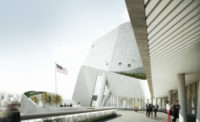
The 37-story building at 20 Fenchurch Street in London was first nicknamed the Walkie-Talkie, for its shape, and then the Walkie-Scorchie, for its reflectivity. Sun bouncing off its south façade melted part of a car last year, exciting tabloid editors and sending the building’s owners searching for a fix.
 |
| Image via City of London 20 Fenchurch's original facade. |
That solution came from the building’s architect, Rafael Viñoly, and George Loisos, an Alameda, California-based architect and consultant. The two designed a system of aluminum fins for the 3rd through 33rd floors of the building’s south facade. The fins, according to a report commissioned by the developer, Land Securities/Canary Wharf Group, and filed with the City of London, “will act as a physical barrier to sunlight striking the building and also to sunlight being reflected from the building.”
The fins, which the developer refers to as brise soleils, were manufactured by Permasteelisa, the Italian company that made the original curtain wall, and are already visible on the south side of the building, where they hang from aluminum brackets.
The fix can only feel like vindication for Viñoly, who has complained that the louvers he originally designed for the building were eliminated by the developer as part of the value engineering process. According to a report submitted to the City of London by consultant Richard Coleman of Citydesigner/Millerhare, the installation of the fins is “clearly an enhancement to the building’s appearance.” Coleman went on to say that the fins add “texture of considerable depth” and a “softer surface quality” to the building’s south façade.
Without the fins, the facade was “basically a humongous concave mirror,” said Loisos, who spoke at a conference in New York. He said he and Viñoly tried many solutions before deciding on the fins, and then built full-size mock-ups of the system. The fins’ effectiveness in blocking sunlight and their effect on the building’s appearance were only two of the many criteria they looked at. Another was how the fins would affect views from inside, with both standing and sitting positions of workers taken into consideration.
“We solved it in a very elegant way,” Loisos said. A spokesman for Land Securities/Canary Wharf Group said that the cost of the fins was in the single digits, meaning under 10 million pounds (or under $16 million). The overall cost of the building has been estimated at over $300 million.
Loisos had previously worked on another Viñoly building, the Vdara Hotel, part of CityCenter in Las Vegas, which was built before—but designed after—20 Fenchurch. There, reflective glass was increasing the sun’s reflection to about 12 times its normal intensity, he said. (To measure intensity that high, he had to use pyroheliometers designed for outer space, where solar radiation is stronger than on the earth’s surface.) By putting a custom film on the glass, he was able to significantly reduce the intensity of the reflection, he said.
Altogether, Loisos says, he has worked on some 25 excess-reflectivity problems in the last two years. “It’s best if they call us before they start construction,” he said of developers. “But more often, we get a call: ‘We’ve started putting up the glass and we have a problem.’ These are expensive mistakes, but solvable,” he said.


